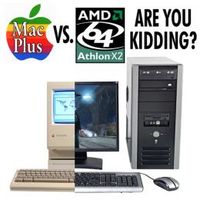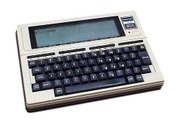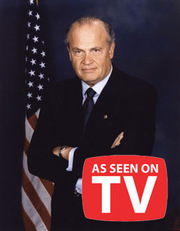Since the dawn of the PC age it’s amazing how little computing has changed. (Picture from Hal Licino. Thanks to Grungy.)
We work with bigger files. We can access big files remotely. We do TV and radio and film. But the basic computing paradigm remains that of the Dynabook, first conceived by Alan Kay in the 1970s. The rest is bells and whistles and details.
In terms of my own personal productivity, the best portable machine I ever had was my TRS-80 Model 100. Wikipedia says this is the last computer for which Bill Gates personally wrote firmware, and he did good. The TRS-80 was light, just four pounds, it ran for hours on batteries, it stored up to 16 pages of notes (more with a 32K memory expansion), and its 300 baud modem let you move those files fairly quickly (given their size).
The Macintosh is really nothing more than Alan Kay’s ideas made Apple,
and Microsoft Windows was their application to Intel hardware. Have
those things advanced much?
Hal Licino says no,
and unlike me, he has gone to the trouble of proving it. He recently
set a 1986 Macintosh Plus, which had networking and multi-tasking
built-in, against a 2007 AMD DualCore running Windows XP. He set the
machines up, and ordered up an identical set of office-oriented tasks.
The only bogey in the mix was that he put Microsoft applications on the
Mac, which didn’t emerge until two years after its debut.
You can probably guess what happened:
For the functions that people use most often, the 1986 vintage Mac Plus
beats the 2007 AMD Athlon 64 X2 4800+: 9 tests to 8! Out of the 17
tests, the antique Mac won 53% of the time! Including a jaw-dropping 52
second whipping of the AMD from the time the Power button is pushed to
the time the Desktop is up and useable.
This does not surprise me. The functions of PC computing have changed
little in 20 years, only the file sizes have changed. And the sizes of
the programs required to process those files. Thanks to the bloatware
of Bill Gates’ army of programmers, the work he did 25 years ago is
still the best he’s ever come up with.












